A Literature Review on Early Interventions for Children with Autism
VerifiedAdded on 2023/06/10
|18
|5239
|185
Literature Review
AI Summary
This literature review investigates the effectiveness of early interventions for children with Autism Spectrum Disorder (ASD) within health and social care contexts. It addresses how early interventions can mitigate the impact of ASD, emphasizing developmental progress and early identification. The review synthesizes findings from multiple studies, highlighting the importance of behavioral and developmental approaches, active family involvement, and culturally sensitive interventions. Key themes include promoting developmental progress through early interventions, enhancing early identification of ASD via policy changes, and addressing challenges such as workforce limitations and the need for standardized progress measurement. The review also identifies gaps in current research, advocating for studies that consider socio-cultural diversity and familial factors, ultimately aiming to improve the quality of life for children with ASD.

Running head: HEALTH AND SOCIAL CARE
Foundations of Inquiry in Health and Social Care
Name of student:
Name of university:
Author note:
Foundations of Inquiry in Health and Social Care
Name of student:
Name of university:
Author note:
Paraphrase This Document
Need a fresh take? Get an instant paraphrase of this document with our AI Paraphraser
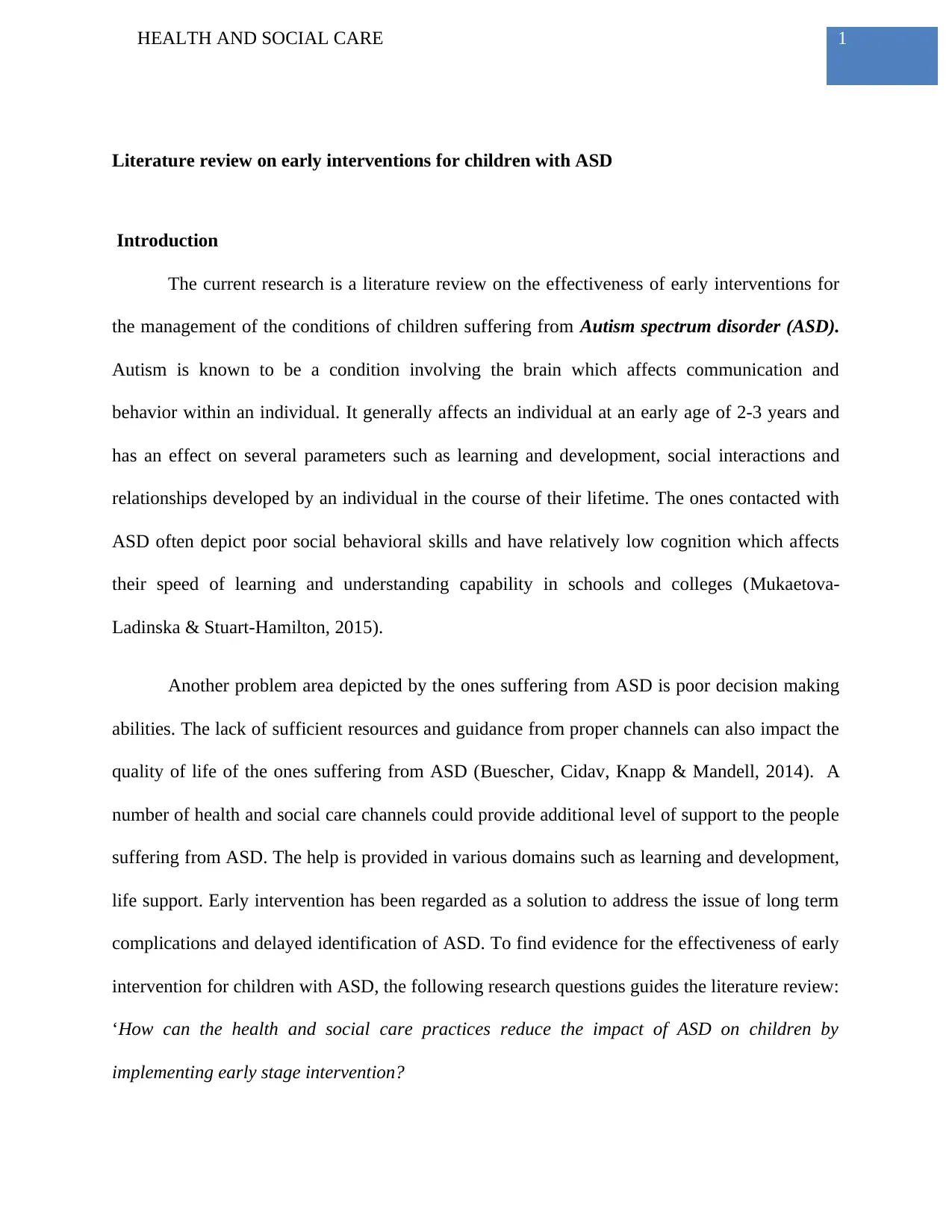
1HEALTH AND SOCIAL CARE
Literature review on early interventions for children with ASD
Introduction
The current research is a literature review on the effectiveness of early interventions for
the management of the conditions of children suffering from Autism spectrum disorder (ASD).
Autism is known to be a condition involving the brain which affects communication and
behavior within an individual. It generally affects an individual at an early age of 2-3 years and
has an effect on several parameters such as learning and development, social interactions and
relationships developed by an individual in the course of their lifetime. The ones contacted with
ASD often depict poor social behavioral skills and have relatively low cognition which affects
their speed of learning and understanding capability in schools and colleges (Mukaetova-
Ladinska & Stuart-Hamilton, 2015).
Another problem area depicted by the ones suffering from ASD is poor decision making
abilities. The lack of sufficient resources and guidance from proper channels can also impact the
quality of life of the ones suffering from ASD (Buescher, Cidav, Knapp & Mandell, 2014). A
number of health and social care channels could provide additional level of support to the people
suffering from ASD. The help is provided in various domains such as learning and development,
life support. Early intervention has been regarded as a solution to address the issue of long term
complications and delayed identification of ASD. To find evidence for the effectiveness of early
intervention for children with ASD, the following research questions guides the literature review:
‘How can the health and social care practices reduce the impact of ASD on children by
implementing early stage intervention?
Literature review on early interventions for children with ASD
Introduction
The current research is a literature review on the effectiveness of early interventions for
the management of the conditions of children suffering from Autism spectrum disorder (ASD).
Autism is known to be a condition involving the brain which affects communication and
behavior within an individual. It generally affects an individual at an early age of 2-3 years and
has an effect on several parameters such as learning and development, social interactions and
relationships developed by an individual in the course of their lifetime. The ones contacted with
ASD often depict poor social behavioral skills and have relatively low cognition which affects
their speed of learning and understanding capability in schools and colleges (Mukaetova-
Ladinska & Stuart-Hamilton, 2015).
Another problem area depicted by the ones suffering from ASD is poor decision making
abilities. The lack of sufficient resources and guidance from proper channels can also impact the
quality of life of the ones suffering from ASD (Buescher, Cidav, Knapp & Mandell, 2014). A
number of health and social care channels could provide additional level of support to the people
suffering from ASD. The help is provided in various domains such as learning and development,
life support. Early intervention has been regarded as a solution to address the issue of long term
complications and delayed identification of ASD. To find evidence for the effectiveness of early
intervention for children with ASD, the following research questions guides the literature review:
‘How can the health and social care practices reduce the impact of ASD on children by
implementing early stage intervention?
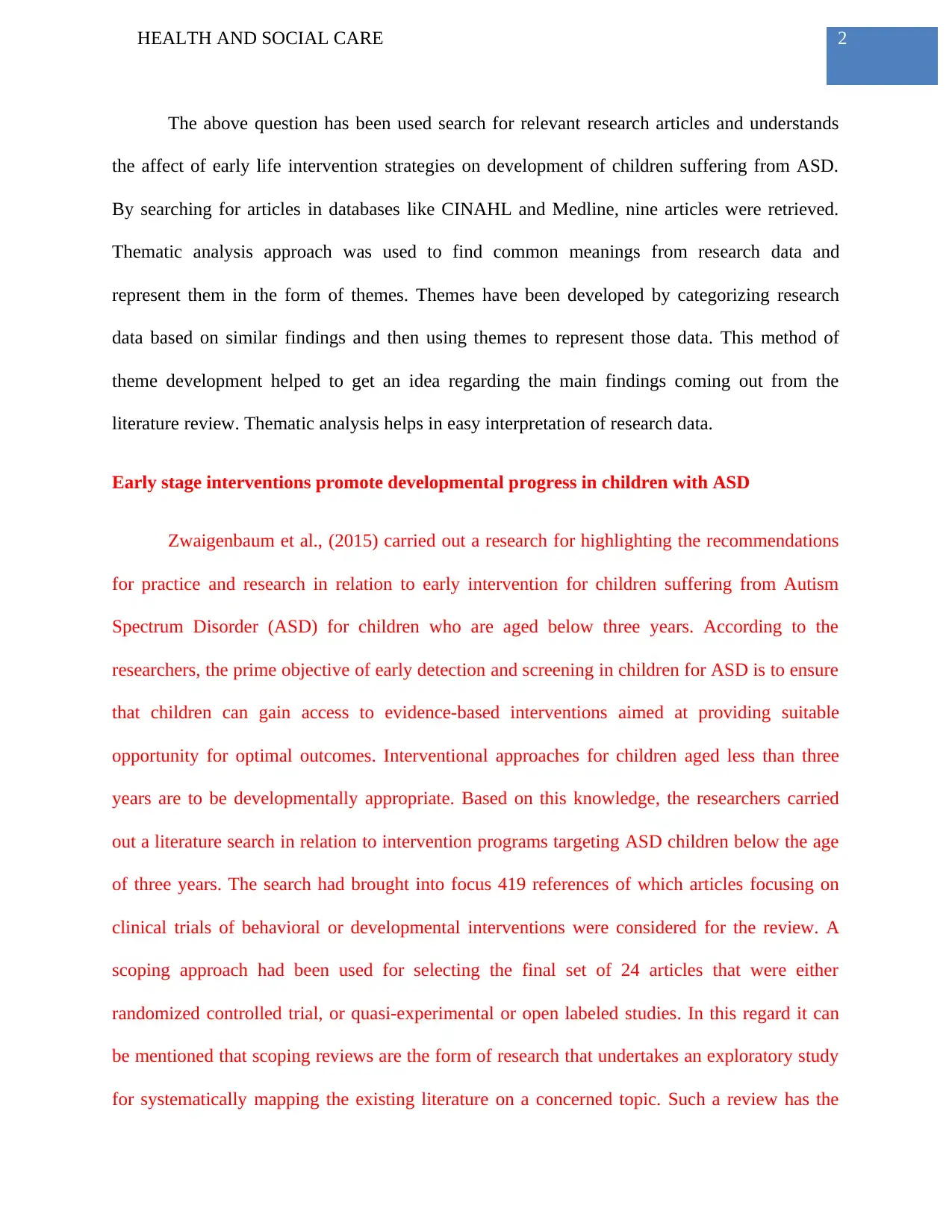
2HEALTH AND SOCIAL CARE
The above question has been used search for relevant research articles and understands
the affect of early life intervention strategies on development of children suffering from ASD.
By searching for articles in databases like CINAHL and Medline, nine articles were retrieved.
Thematic analysis approach was used to find common meanings from research data and
represent them in the form of themes. Themes have been developed by categorizing research
data based on similar findings and then using themes to represent those data. This method of
theme development helped to get an idea regarding the main findings coming out from the
literature review. Thematic analysis helps in easy interpretation of research data.
Early stage interventions promote developmental progress in children with ASD
Zwaigenbaum et al., (2015) carried out a research for highlighting the recommendations
for practice and research in relation to early intervention for children suffering from Autism
Spectrum Disorder (ASD) for children who are aged below three years. According to the
researchers, the prime objective of early detection and screening in children for ASD is to ensure
that children can gain access to evidence-based interventions aimed at providing suitable
opportunity for optimal outcomes. Interventional approaches for children aged less than three
years are to be developmentally appropriate. Based on this knowledge, the researchers carried
out a literature search in relation to intervention programs targeting ASD children below the age
of three years. The search had brought into focus 419 references of which articles focusing on
clinical trials of behavioral or developmental interventions were considered for the review. A
scoping approach had been used for selecting the final set of 24 articles that were either
randomized controlled trial, or quasi-experimental or open labeled studies. In this regard it can
be mentioned that scoping reviews are the form of research that undertakes an exploratory study
for systematically mapping the existing literature on a concerned topic. Such a review has the
The above question has been used search for relevant research articles and understands
the affect of early life intervention strategies on development of children suffering from ASD.
By searching for articles in databases like CINAHL and Medline, nine articles were retrieved.
Thematic analysis approach was used to find common meanings from research data and
represent them in the form of themes. Themes have been developed by categorizing research
data based on similar findings and then using themes to represent those data. This method of
theme development helped to get an idea regarding the main findings coming out from the
literature review. Thematic analysis helps in easy interpretation of research data.
Early stage interventions promote developmental progress in children with ASD
Zwaigenbaum et al., (2015) carried out a research for highlighting the recommendations
for practice and research in relation to early intervention for children suffering from Autism
Spectrum Disorder (ASD) for children who are aged below three years. According to the
researchers, the prime objective of early detection and screening in children for ASD is to ensure
that children can gain access to evidence-based interventions aimed at providing suitable
opportunity for optimal outcomes. Interventional approaches for children aged less than three
years are to be developmentally appropriate. Based on this knowledge, the researchers carried
out a literature search in relation to intervention programs targeting ASD children below the age
of three years. The search had brought into focus 419 references of which articles focusing on
clinical trials of behavioral or developmental interventions were considered for the review. A
scoping approach had been used for selecting the final set of 24 articles that were either
randomized controlled trial, or quasi-experimental or open labeled studies. In this regard it can
be mentioned that scoping reviews are the form of research that undertakes an exploratory study
for systematically mapping the existing literature on a concerned topic. Such a review has the
⊘ This is a preview!⊘
Do you want full access?
Subscribe today to unlock all pages.

Trusted by 1+ million students worldwide
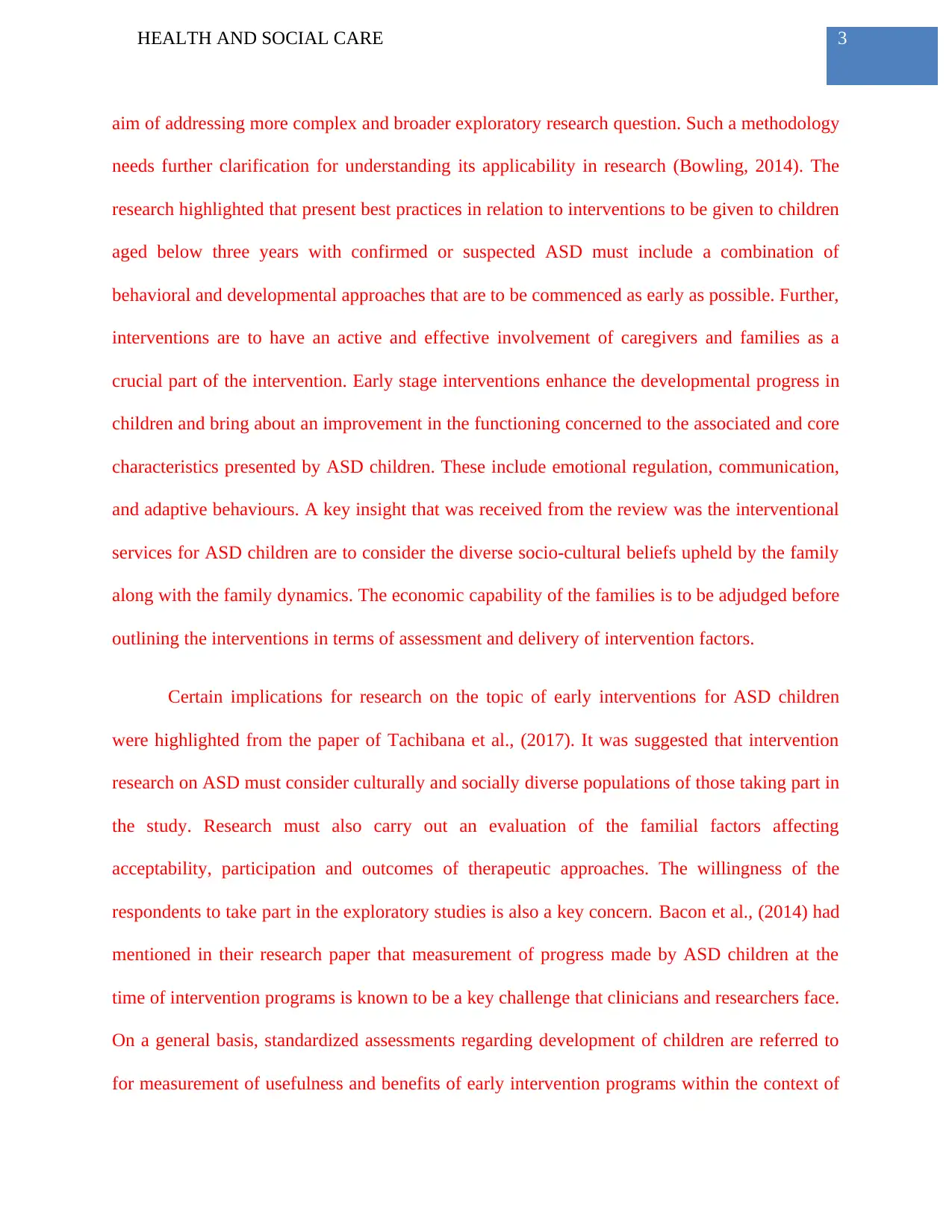
3HEALTH AND SOCIAL CARE
aim of addressing more complex and broader exploratory research question. Such a methodology
needs further clarification for understanding its applicability in research (Bowling, 2014). The
research highlighted that present best practices in relation to interventions to be given to children
aged below three years with confirmed or suspected ASD must include a combination of
behavioral and developmental approaches that are to be commenced as early as possible. Further,
interventions are to have an active and effective involvement of caregivers and families as a
crucial part of the intervention. Early stage interventions enhance the developmental progress in
children and bring about an improvement in the functioning concerned to the associated and core
characteristics presented by ASD children. These include emotional regulation, communication,
and adaptive behaviours. A key insight that was received from the review was the interventional
services for ASD children are to consider the diverse socio-cultural beliefs upheld by the family
along with the family dynamics. The economic capability of the families is to be adjudged before
outlining the interventions in terms of assessment and delivery of intervention factors.
Certain implications for research on the topic of early interventions for ASD children
were highlighted from the paper of Tachibana et al., (2017). It was suggested that intervention
research on ASD must consider culturally and socially diverse populations of those taking part in
the study. Research must also carry out an evaluation of the familial factors affecting
acceptability, participation and outcomes of therapeutic approaches. The willingness of the
respondents to take part in the exploratory studies is also a key concern. Bacon et al., (2014) had
mentioned in their research paper that measurement of progress made by ASD children at the
time of intervention programs is known to be a key challenge that clinicians and researchers face.
On a general basis, standardized assessments regarding development of children are referred to
for measurement of usefulness and benefits of early intervention programs within the context of
aim of addressing more complex and broader exploratory research question. Such a methodology
needs further clarification for understanding its applicability in research (Bowling, 2014). The
research highlighted that present best practices in relation to interventions to be given to children
aged below three years with confirmed or suspected ASD must include a combination of
behavioral and developmental approaches that are to be commenced as early as possible. Further,
interventions are to have an active and effective involvement of caregivers and families as a
crucial part of the intervention. Early stage interventions enhance the developmental progress in
children and bring about an improvement in the functioning concerned to the associated and core
characteristics presented by ASD children. These include emotional regulation, communication,
and adaptive behaviours. A key insight that was received from the review was the interventional
services for ASD children are to consider the diverse socio-cultural beliefs upheld by the family
along with the family dynamics. The economic capability of the families is to be adjudged before
outlining the interventions in terms of assessment and delivery of intervention factors.
Certain implications for research on the topic of early interventions for ASD children
were highlighted from the paper of Tachibana et al., (2017). It was suggested that intervention
research on ASD must consider culturally and socially diverse populations of those taking part in
the study. Research must also carry out an evaluation of the familial factors affecting
acceptability, participation and outcomes of therapeutic approaches. The willingness of the
respondents to take part in the exploratory studies is also a key concern. Bacon et al., (2014) had
mentioned in their research paper that measurement of progress made by ASD children at the
time of intervention programs is known to be a key challenge that clinicians and researchers face.
On a general basis, standardized assessments regarding development of children are referred to
for measurement of usefulness and benefits of early intervention programs within the context of
Paraphrase This Document
Need a fresh take? Get an instant paraphrase of this document with our AI Paraphraser
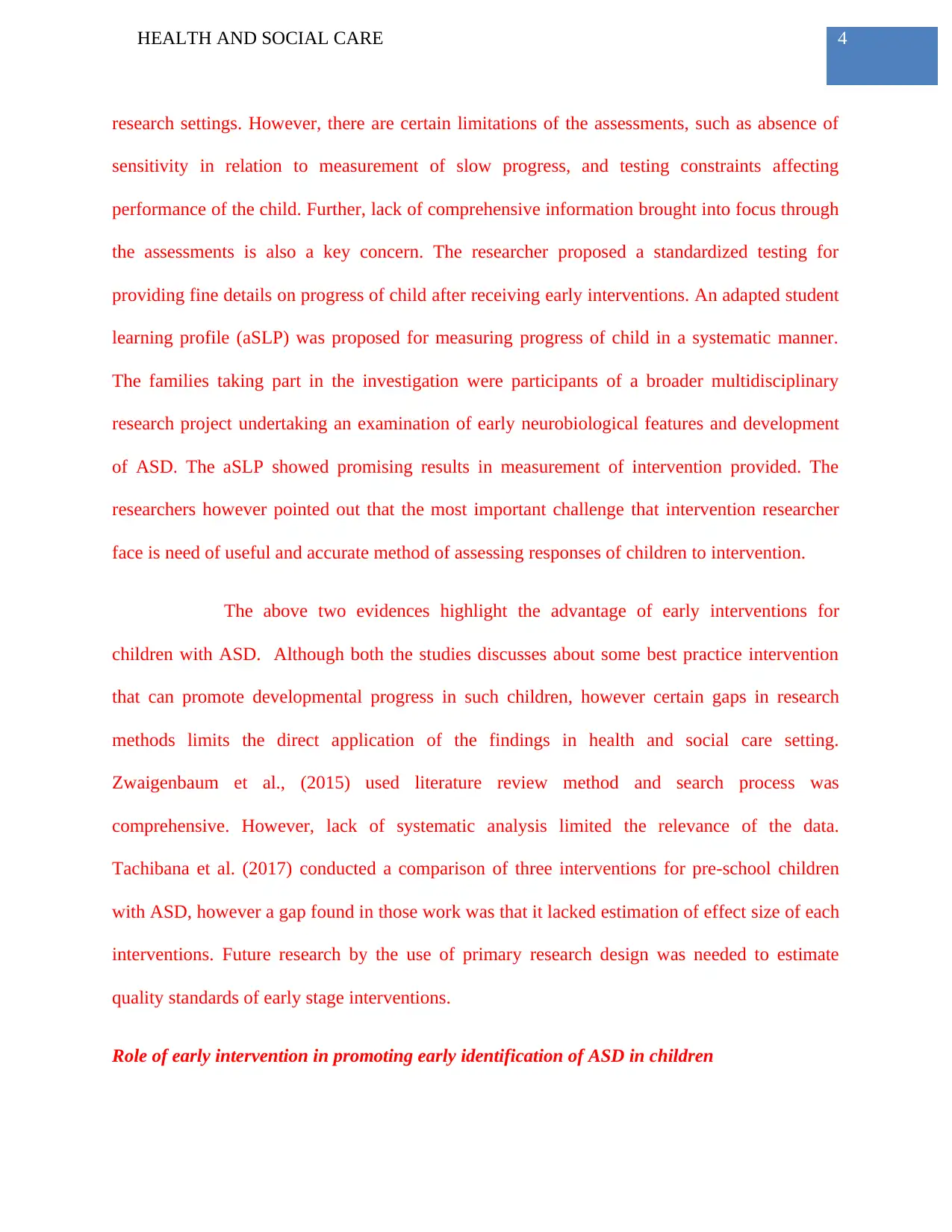
4HEALTH AND SOCIAL CARE
research settings. However, there are certain limitations of the assessments, such as absence of
sensitivity in relation to measurement of slow progress, and testing constraints affecting
performance of the child. Further, lack of comprehensive information brought into focus through
the assessments is also a key concern. The researcher proposed a standardized testing for
providing fine details on progress of child after receiving early interventions. An adapted student
learning profile (aSLP) was proposed for measuring progress of child in a systematic manner.
The families taking part in the investigation were participants of a broader multidisciplinary
research project undertaking an examination of early neurobiological features and development
of ASD. The aSLP showed promising results in measurement of intervention provided. The
researchers however pointed out that the most important challenge that intervention researcher
face is need of useful and accurate method of assessing responses of children to intervention.
The above two evidences highlight the advantage of early interventions for
children with ASD. Although both the studies discusses about some best practice intervention
that can promote developmental progress in such children, however certain gaps in research
methods limits the direct application of the findings in health and social care setting.
Zwaigenbaum et al., (2015) used literature review method and search process was
comprehensive. However, lack of systematic analysis limited the relevance of the data.
Tachibana et al. (2017) conducted a comparison of three interventions for pre-school children
with ASD, however a gap found in those work was that it lacked estimation of effect size of each
interventions. Future research by the use of primary research design was needed to estimate
quality standards of early stage interventions.
Role of early intervention in promoting early identification of ASD in children
research settings. However, there are certain limitations of the assessments, such as absence of
sensitivity in relation to measurement of slow progress, and testing constraints affecting
performance of the child. Further, lack of comprehensive information brought into focus through
the assessments is also a key concern. The researcher proposed a standardized testing for
providing fine details on progress of child after receiving early interventions. An adapted student
learning profile (aSLP) was proposed for measuring progress of child in a systematic manner.
The families taking part in the investigation were participants of a broader multidisciplinary
research project undertaking an examination of early neurobiological features and development
of ASD. The aSLP showed promising results in measurement of intervention provided. The
researchers however pointed out that the most important challenge that intervention researcher
face is need of useful and accurate method of assessing responses of children to intervention.
The above two evidences highlight the advantage of early interventions for
children with ASD. Although both the studies discusses about some best practice intervention
that can promote developmental progress in such children, however certain gaps in research
methods limits the direct application of the findings in health and social care setting.
Zwaigenbaum et al., (2015) used literature review method and search process was
comprehensive. However, lack of systematic analysis limited the relevance of the data.
Tachibana et al. (2017) conducted a comparison of three interventions for pre-school children
with ASD, however a gap found in those work was that it lacked estimation of effect size of each
interventions. Future research by the use of primary research design was needed to estimate
quality standards of early stage interventions.
Role of early intervention in promoting early identification of ASD in children
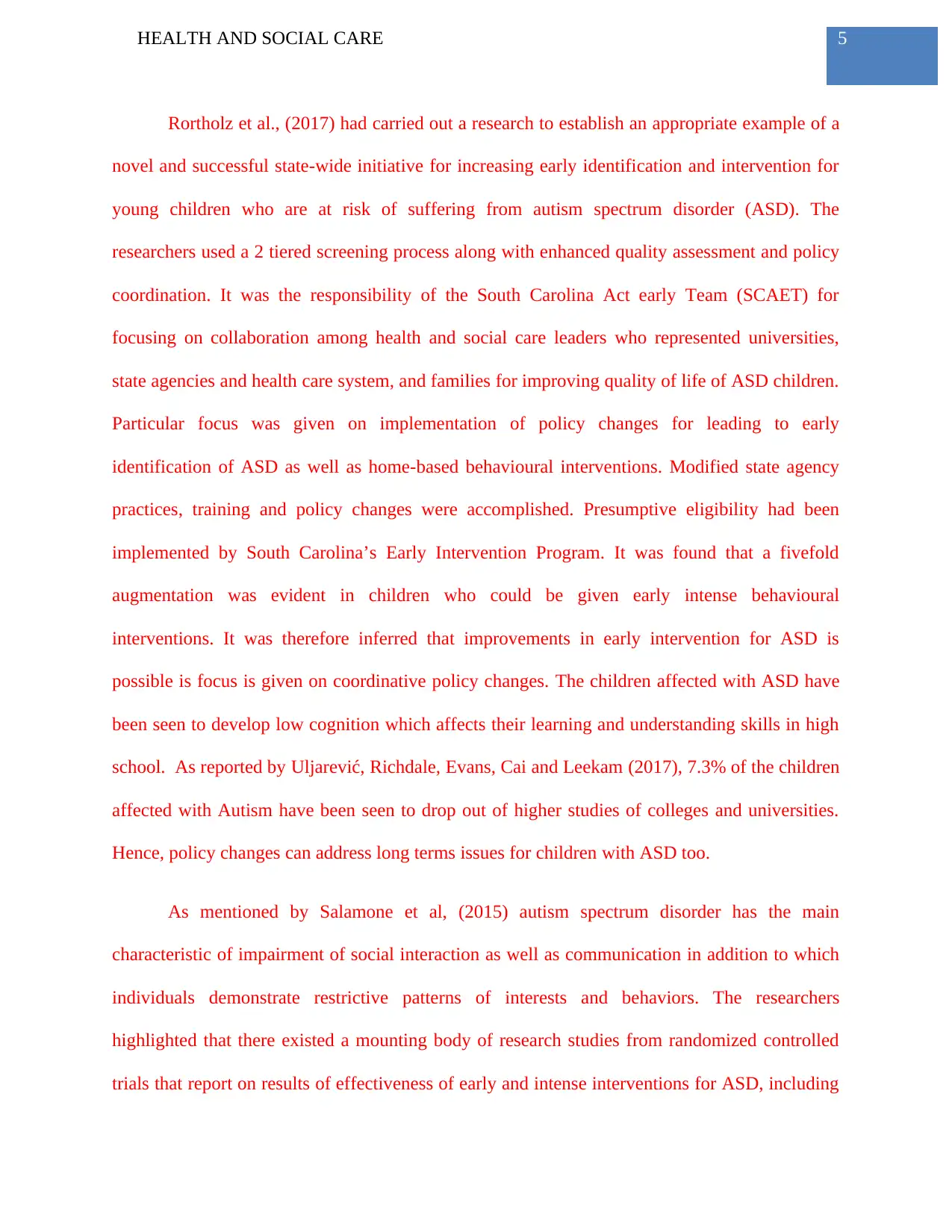
5HEALTH AND SOCIAL CARE
Rortholz et al., (2017) had carried out a research to establish an appropriate example of a
novel and successful state-wide initiative for increasing early identification and intervention for
young children who are at risk of suffering from autism spectrum disorder (ASD). The
researchers used a 2 tiered screening process along with enhanced quality assessment and policy
coordination. It was the responsibility of the South Carolina Act early Team (SCAET) for
focusing on collaboration among health and social care leaders who represented universities,
state agencies and health care system, and families for improving quality of life of ASD children.
Particular focus was given on implementation of policy changes for leading to early
identification of ASD as well as home-based behavioural interventions. Modified state agency
practices, training and policy changes were accomplished. Presumptive eligibility had been
implemented by South Carolina’s Early Intervention Program. It was found that a fivefold
augmentation was evident in children who could be given early intense behavioural
interventions. It was therefore inferred that improvements in early intervention for ASD is
possible is focus is given on coordinative policy changes. The children affected with ASD have
been seen to develop low cognition which affects their learning and understanding skills in high
school. As reported by Uljarević, Richdale, Evans, Cai and Leekam (2017), 7.3% of the children
affected with Autism have been seen to drop out of higher studies of colleges and universities.
Hence, policy changes can address long terms issues for children with ASD too.
As mentioned by Salamone et al, (2015) autism spectrum disorder has the main
characteristic of impairment of social interaction as well as communication in addition to which
individuals demonstrate restrictive patterns of interests and behaviors. The researchers
highlighted that there existed a mounting body of research studies from randomized controlled
trials that report on results of effectiveness of early and intense interventions for ASD, including
Rortholz et al., (2017) had carried out a research to establish an appropriate example of a
novel and successful state-wide initiative for increasing early identification and intervention for
young children who are at risk of suffering from autism spectrum disorder (ASD). The
researchers used a 2 tiered screening process along with enhanced quality assessment and policy
coordination. It was the responsibility of the South Carolina Act early Team (SCAET) for
focusing on collaboration among health and social care leaders who represented universities,
state agencies and health care system, and families for improving quality of life of ASD children.
Particular focus was given on implementation of policy changes for leading to early
identification of ASD as well as home-based behavioural interventions. Modified state agency
practices, training and policy changes were accomplished. Presumptive eligibility had been
implemented by South Carolina’s Early Intervention Program. It was found that a fivefold
augmentation was evident in children who could be given early intense behavioural
interventions. It was therefore inferred that improvements in early intervention for ASD is
possible is focus is given on coordinative policy changes. The children affected with ASD have
been seen to develop low cognition which affects their learning and understanding skills in high
school. As reported by Uljarević, Richdale, Evans, Cai and Leekam (2017), 7.3% of the children
affected with Autism have been seen to drop out of higher studies of colleges and universities.
Hence, policy changes can address long terms issues for children with ASD too.
As mentioned by Salamone et al, (2015) autism spectrum disorder has the main
characteristic of impairment of social interaction as well as communication in addition to which
individuals demonstrate restrictive patterns of interests and behaviors. The researchers
highlighted that there existed a mounting body of research studies from randomized controlled
trials that report on results of effectiveness of early and intense interventions for ASD, including
⊘ This is a preview!⊘
Do you want full access?
Subscribe today to unlock all pages.

Trusted by 1+ million students worldwide
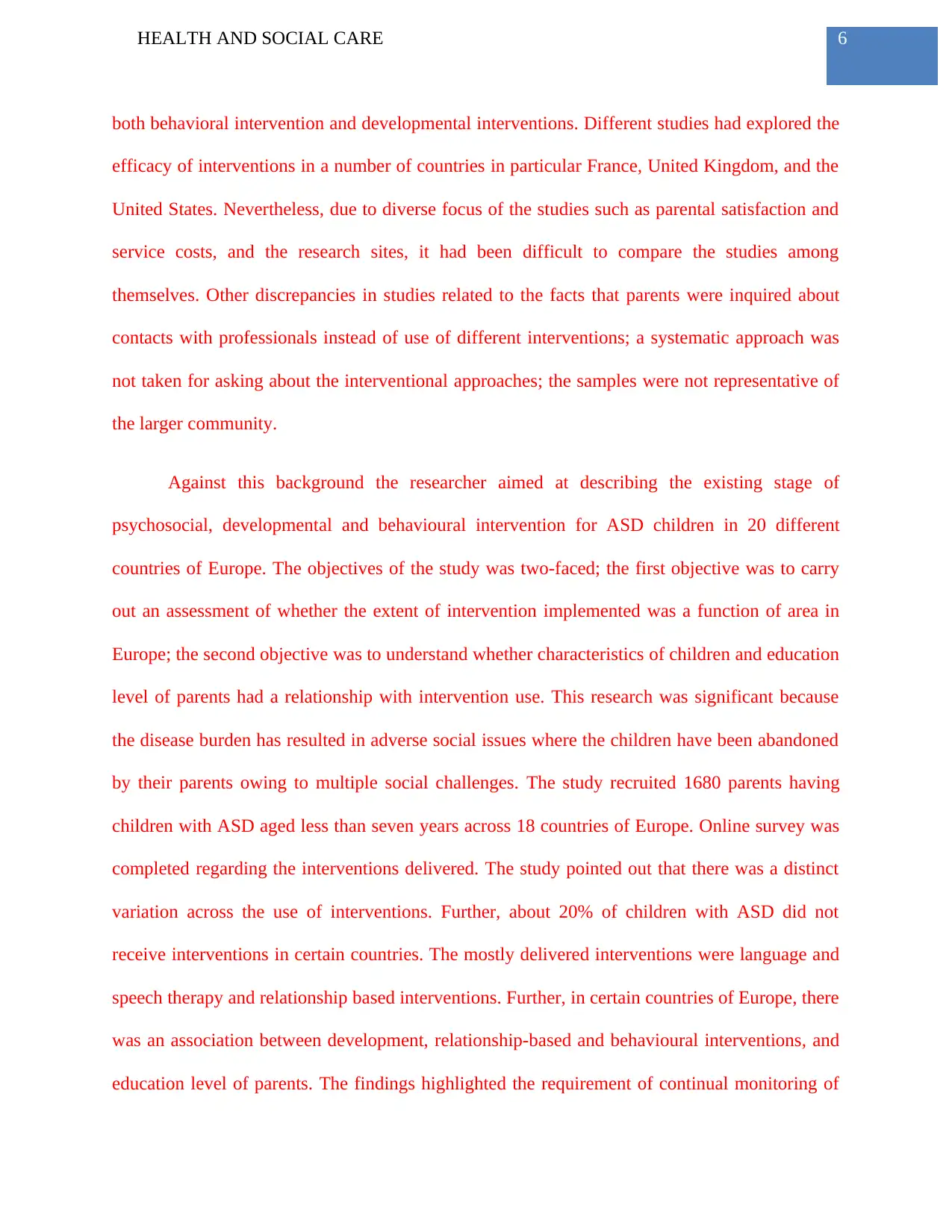
6HEALTH AND SOCIAL CARE
both behavioral intervention and developmental interventions. Different studies had explored the
efficacy of interventions in a number of countries in particular France, United Kingdom, and the
United States. Nevertheless, due to diverse focus of the studies such as parental satisfaction and
service costs, and the research sites, it had been difficult to compare the studies among
themselves. Other discrepancies in studies related to the facts that parents were inquired about
contacts with professionals instead of use of different interventions; a systematic approach was
not taken for asking about the interventional approaches; the samples were not representative of
the larger community.
Against this background the researcher aimed at describing the existing stage of
psychosocial, developmental and behavioural intervention for ASD children in 20 different
countries of Europe. The objectives of the study was two-faced; the first objective was to carry
out an assessment of whether the extent of intervention implemented was a function of area in
Europe; the second objective was to understand whether characteristics of children and education
level of parents had a relationship with intervention use. This research was significant because
the disease burden has resulted in adverse social issues where the children have been abandoned
by their parents owing to multiple social challenges. The study recruited 1680 parents having
children with ASD aged less than seven years across 18 countries of Europe. Online survey was
completed regarding the interventions delivered. The study pointed out that there was a distinct
variation across the use of interventions. Further, about 20% of children with ASD did not
receive interventions in certain countries. The mostly delivered interventions were language and
speech therapy and relationship based interventions. Further, in certain countries of Europe, there
was an association between development, relationship-based and behavioural interventions, and
education level of parents. The findings highlighted the requirement of continual monitoring of
both behavioral intervention and developmental interventions. Different studies had explored the
efficacy of interventions in a number of countries in particular France, United Kingdom, and the
United States. Nevertheless, due to diverse focus of the studies such as parental satisfaction and
service costs, and the research sites, it had been difficult to compare the studies among
themselves. Other discrepancies in studies related to the facts that parents were inquired about
contacts with professionals instead of use of different interventions; a systematic approach was
not taken for asking about the interventional approaches; the samples were not representative of
the larger community.
Against this background the researcher aimed at describing the existing stage of
psychosocial, developmental and behavioural intervention for ASD children in 20 different
countries of Europe. The objectives of the study was two-faced; the first objective was to carry
out an assessment of whether the extent of intervention implemented was a function of area in
Europe; the second objective was to understand whether characteristics of children and education
level of parents had a relationship with intervention use. This research was significant because
the disease burden has resulted in adverse social issues where the children have been abandoned
by their parents owing to multiple social challenges. The study recruited 1680 parents having
children with ASD aged less than seven years across 18 countries of Europe. Online survey was
completed regarding the interventions delivered. The study pointed out that there was a distinct
variation across the use of interventions. Further, about 20% of children with ASD did not
receive interventions in certain countries. The mostly delivered interventions were language and
speech therapy and relationship based interventions. Further, in certain countries of Europe, there
was an association between development, relationship-based and behavioural interventions, and
education level of parents. The findings highlighted the requirement of continual monitoring of
Paraphrase This Document
Need a fresh take? Get an instant paraphrase of this document with our AI Paraphraser
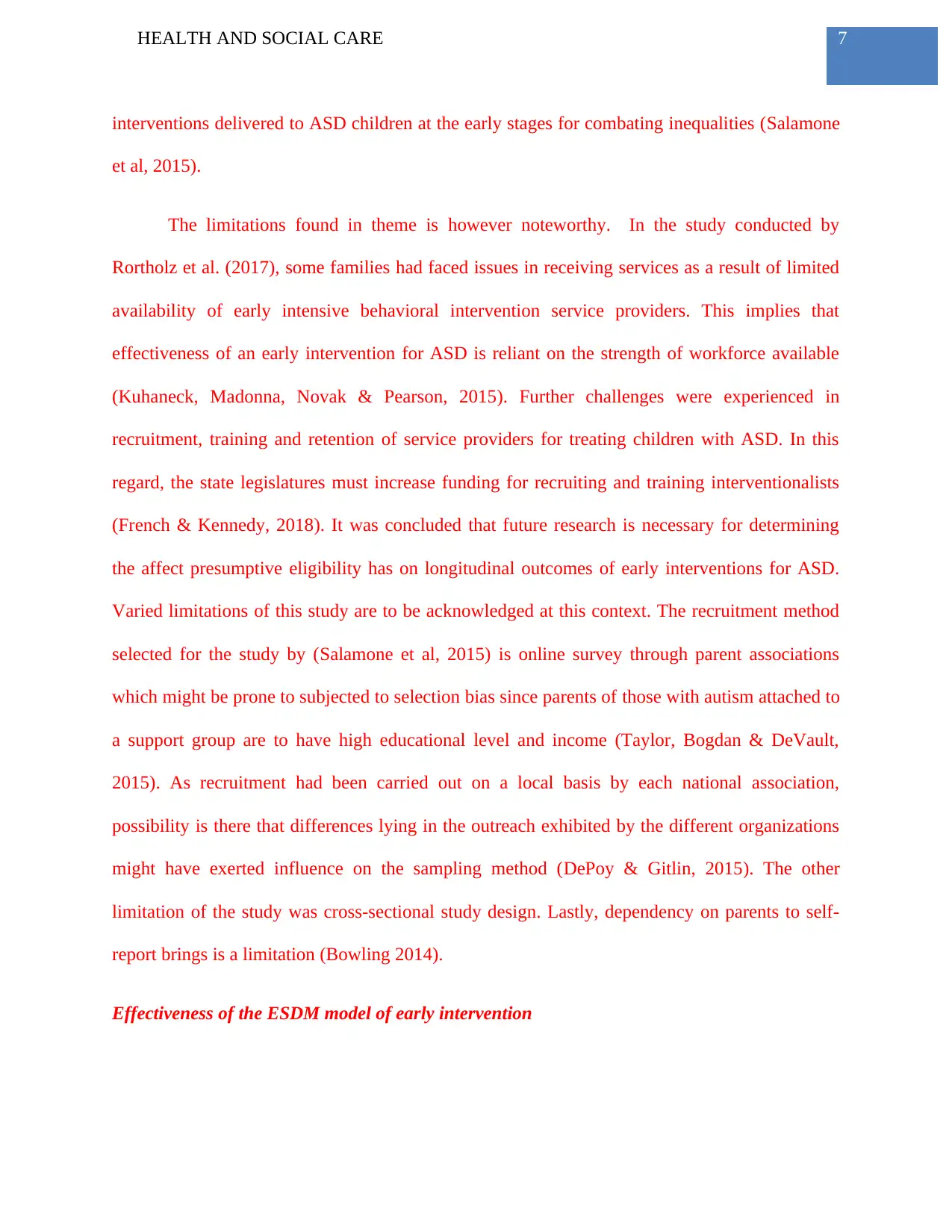
7HEALTH AND SOCIAL CARE
interventions delivered to ASD children at the early stages for combating inequalities (Salamone
et al, 2015).
The limitations found in theme is however noteworthy. In the study conducted by
Rortholz et al. (2017), some families had faced issues in receiving services as a result of limited
availability of early intensive behavioral intervention service providers. This implies that
effectiveness of an early intervention for ASD is reliant on the strength of workforce available
(Kuhaneck, Madonna, Novak & Pearson, 2015). Further challenges were experienced in
recruitment, training and retention of service providers for treating children with ASD. In this
regard, the state legislatures must increase funding for recruiting and training interventionalists
(French & Kennedy, 2018). It was concluded that future research is necessary for determining
the affect presumptive eligibility has on longitudinal outcomes of early interventions for ASD.
Varied limitations of this study are to be acknowledged at this context. The recruitment method
selected for the study by (Salamone et al, 2015) is online survey through parent associations
which might be prone to subjected to selection bias since parents of those with autism attached to
a support group are to have high educational level and income (Taylor, Bogdan & DeVault,
2015). As recruitment had been carried out on a local basis by each national association,
possibility is there that differences lying in the outreach exhibited by the different organizations
might have exerted influence on the sampling method (DePoy & Gitlin, 2015). The other
limitation of the study was cross-sectional study design. Lastly, dependency on parents to self-
report brings is a limitation (Bowling 2014).
Effectiveness of the ESDM model of early intervention
interventions delivered to ASD children at the early stages for combating inequalities (Salamone
et al, 2015).
The limitations found in theme is however noteworthy. In the study conducted by
Rortholz et al. (2017), some families had faced issues in receiving services as a result of limited
availability of early intensive behavioral intervention service providers. This implies that
effectiveness of an early intervention for ASD is reliant on the strength of workforce available
(Kuhaneck, Madonna, Novak & Pearson, 2015). Further challenges were experienced in
recruitment, training and retention of service providers for treating children with ASD. In this
regard, the state legislatures must increase funding for recruiting and training interventionalists
(French & Kennedy, 2018). It was concluded that future research is necessary for determining
the affect presumptive eligibility has on longitudinal outcomes of early interventions for ASD.
Varied limitations of this study are to be acknowledged at this context. The recruitment method
selected for the study by (Salamone et al, 2015) is online survey through parent associations
which might be prone to subjected to selection bias since parents of those with autism attached to
a support group are to have high educational level and income (Taylor, Bogdan & DeVault,
2015). As recruitment had been carried out on a local basis by each national association,
possibility is there that differences lying in the outreach exhibited by the different organizations
might have exerted influence on the sampling method (DePoy & Gitlin, 2015). The other
limitation of the study was cross-sectional study design. Lastly, dependency on parents to self-
report brings is a limitation (Bowling 2014).
Effectiveness of the ESDM model of early intervention
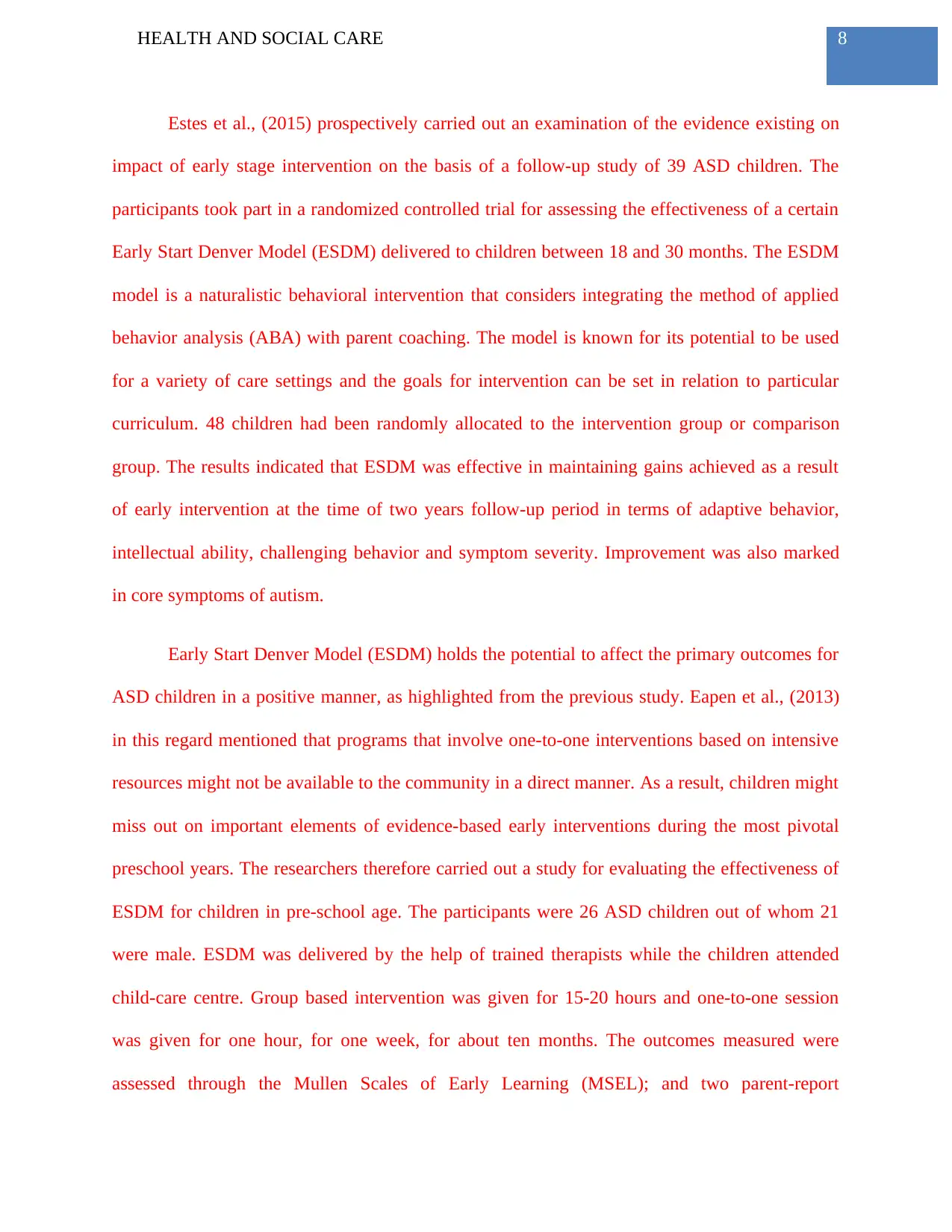
8HEALTH AND SOCIAL CARE
Estes et al., (2015) prospectively carried out an examination of the evidence existing on
impact of early stage intervention on the basis of a follow-up study of 39 ASD children. The
participants took part in a randomized controlled trial for assessing the effectiveness of a certain
Early Start Denver Model (ESDM) delivered to children between 18 and 30 months. The ESDM
model is a naturalistic behavioral intervention that considers integrating the method of applied
behavior analysis (ABA) with parent coaching. The model is known for its potential to be used
for a variety of care settings and the goals for intervention can be set in relation to particular
curriculum. 48 children had been randomly allocated to the intervention group or comparison
group. The results indicated that ESDM was effective in maintaining gains achieved as a result
of early intervention at the time of two years follow-up period in terms of adaptive behavior,
intellectual ability, challenging behavior and symptom severity. Improvement was also marked
in core symptoms of autism.
Early Start Denver Model (ESDM) holds the potential to affect the primary outcomes for
ASD children in a positive manner, as highlighted from the previous study. Eapen et al., (2013)
in this regard mentioned that programs that involve one-to-one interventions based on intensive
resources might not be available to the community in a direct manner. As a result, children might
miss out on important elements of evidence-based early interventions during the most pivotal
preschool years. The researchers therefore carried out a study for evaluating the effectiveness of
ESDM for children in pre-school age. The participants were 26 ASD children out of whom 21
were male. ESDM was delivered by the help of trained therapists while the children attended
child-care centre. Group based intervention was given for 15-20 hours and one-to-one session
was given for one hour, for one week, for about ten months. The outcomes measured were
assessed through the Mullen Scales of Early Learning (MSEL); and two parent-report
Estes et al., (2015) prospectively carried out an examination of the evidence existing on
impact of early stage intervention on the basis of a follow-up study of 39 ASD children. The
participants took part in a randomized controlled trial for assessing the effectiveness of a certain
Early Start Denver Model (ESDM) delivered to children between 18 and 30 months. The ESDM
model is a naturalistic behavioral intervention that considers integrating the method of applied
behavior analysis (ABA) with parent coaching. The model is known for its potential to be used
for a variety of care settings and the goals for intervention can be set in relation to particular
curriculum. 48 children had been randomly allocated to the intervention group or comparison
group. The results indicated that ESDM was effective in maintaining gains achieved as a result
of early intervention at the time of two years follow-up period in terms of adaptive behavior,
intellectual ability, challenging behavior and symptom severity. Improvement was also marked
in core symptoms of autism.
Early Start Denver Model (ESDM) holds the potential to affect the primary outcomes for
ASD children in a positive manner, as highlighted from the previous study. Eapen et al., (2013)
in this regard mentioned that programs that involve one-to-one interventions based on intensive
resources might not be available to the community in a direct manner. As a result, children might
miss out on important elements of evidence-based early interventions during the most pivotal
preschool years. The researchers therefore carried out a study for evaluating the effectiveness of
ESDM for children in pre-school age. The participants were 26 ASD children out of whom 21
were male. ESDM was delivered by the help of trained therapists while the children attended
child-care centre. Group based intervention was given for 15-20 hours and one-to-one session
was given for one hour, for one week, for about ten months. The outcomes measured were
assessed through the Mullen Scales of Early Learning (MSEL); and two parent-report
⊘ This is a preview!⊘
Do you want full access?
Subscribe today to unlock all pages.

Trusted by 1+ million students worldwide
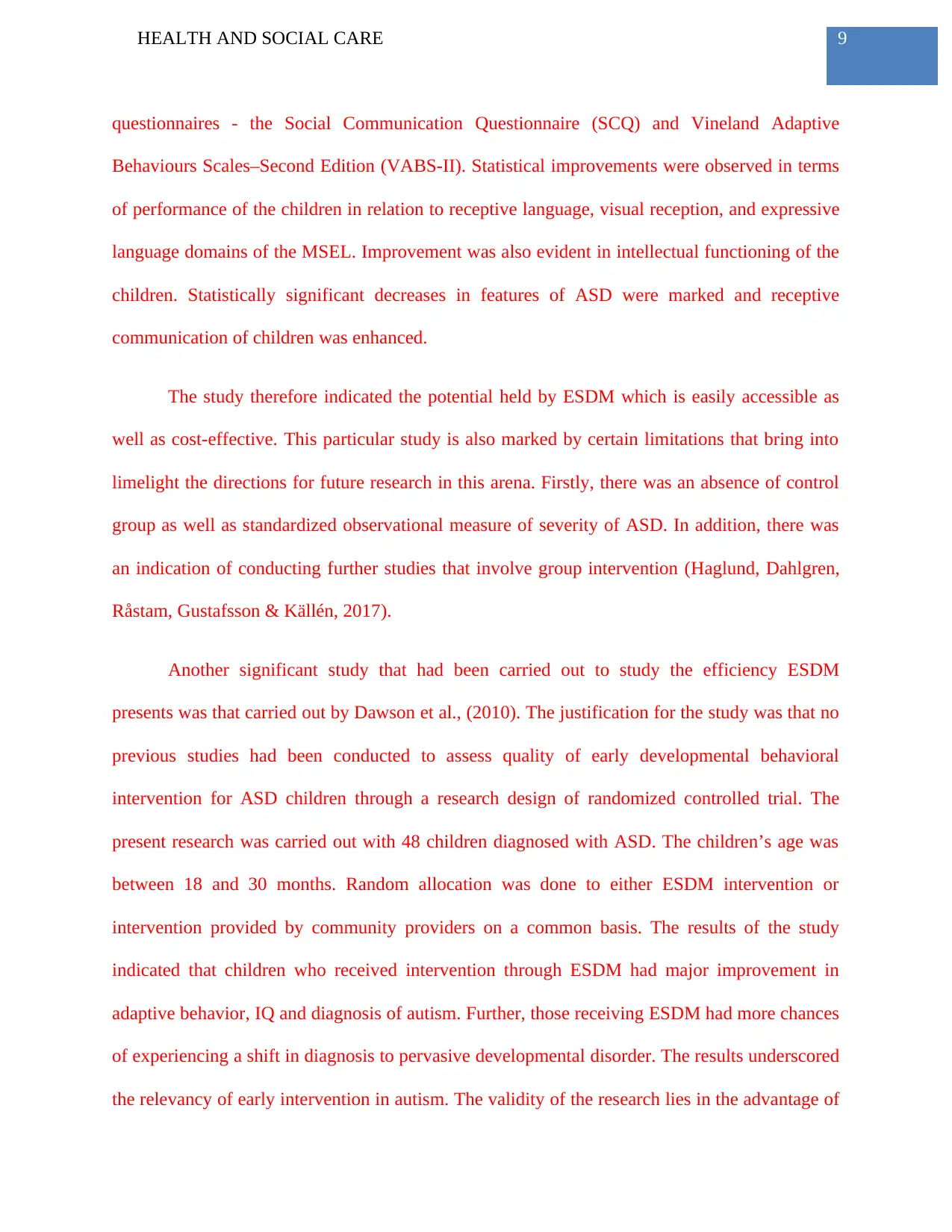
9HEALTH AND SOCIAL CARE
questionnaires - the Social Communication Questionnaire (SCQ) and Vineland Adaptive
Behaviours Scales–Second Edition (VABS-II). Statistical improvements were observed in terms
of performance of the children in relation to receptive language, visual reception, and expressive
language domains of the MSEL. Improvement was also evident in intellectual functioning of the
children. Statistically significant decreases in features of ASD were marked and receptive
communication of children was enhanced.
The study therefore indicated the potential held by ESDM which is easily accessible as
well as cost-effective. This particular study is also marked by certain limitations that bring into
limelight the directions for future research in this arena. Firstly, there was an absence of control
group as well as standardized observational measure of severity of ASD. In addition, there was
an indication of conducting further studies that involve group intervention (Haglund, Dahlgren,
Råstam, Gustafsson & Källén, 2017).
Another significant study that had been carried out to study the efficiency ESDM
presents was that carried out by Dawson et al., (2010). The justification for the study was that no
previous studies had been conducted to assess quality of early developmental behavioral
intervention for ASD children through a research design of randomized controlled trial. The
present research was carried out with 48 children diagnosed with ASD. The children’s age was
between 18 and 30 months. Random allocation was done to either ESDM intervention or
intervention provided by community providers on a common basis. The results of the study
indicated that children who received intervention through ESDM had major improvement in
adaptive behavior, IQ and diagnosis of autism. Further, those receiving ESDM had more chances
of experiencing a shift in diagnosis to pervasive developmental disorder. The results underscored
the relevancy of early intervention in autism. The validity of the research lies in the advantage of
questionnaires - the Social Communication Questionnaire (SCQ) and Vineland Adaptive
Behaviours Scales–Second Edition (VABS-II). Statistical improvements were observed in terms
of performance of the children in relation to receptive language, visual reception, and expressive
language domains of the MSEL. Improvement was also evident in intellectual functioning of the
children. Statistically significant decreases in features of ASD were marked and receptive
communication of children was enhanced.
The study therefore indicated the potential held by ESDM which is easily accessible as
well as cost-effective. This particular study is also marked by certain limitations that bring into
limelight the directions for future research in this arena. Firstly, there was an absence of control
group as well as standardized observational measure of severity of ASD. In addition, there was
an indication of conducting further studies that involve group intervention (Haglund, Dahlgren,
Råstam, Gustafsson & Källén, 2017).
Another significant study that had been carried out to study the efficiency ESDM
presents was that carried out by Dawson et al., (2010). The justification for the study was that no
previous studies had been conducted to assess quality of early developmental behavioral
intervention for ASD children through a research design of randomized controlled trial. The
present research was carried out with 48 children diagnosed with ASD. The children’s age was
between 18 and 30 months. Random allocation was done to either ESDM intervention or
intervention provided by community providers on a common basis. The results of the study
indicated that children who received intervention through ESDM had major improvement in
adaptive behavior, IQ and diagnosis of autism. Further, those receiving ESDM had more chances
of experiencing a shift in diagnosis to pervasive developmental disorder. The results underscored
the relevancy of early intervention in autism. The validity of the research lies in the advantage of
Paraphrase This Document
Need a fresh take? Get an instant paraphrase of this document with our AI Paraphraser
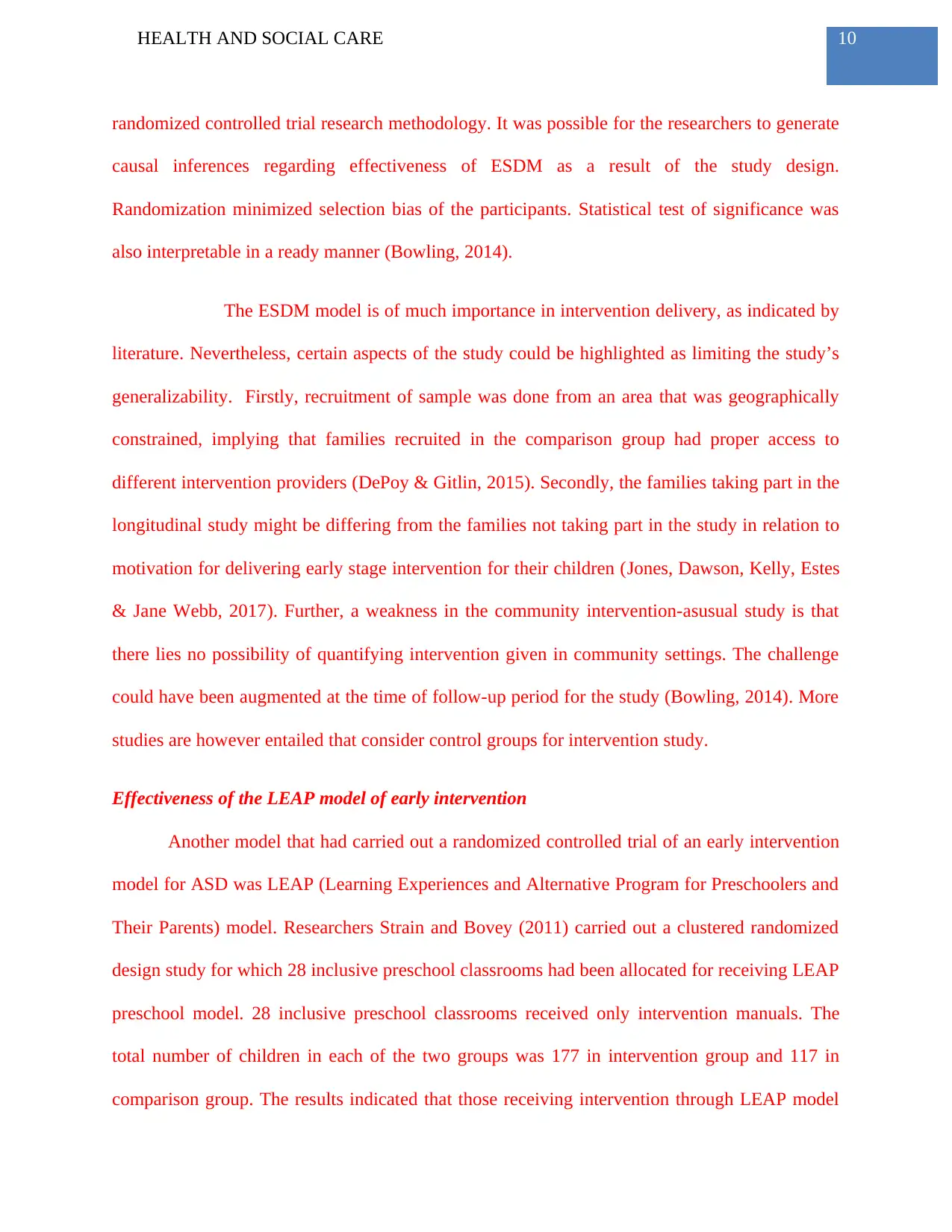
10HEALTH AND SOCIAL CARE
randomized controlled trial research methodology. It was possible for the researchers to generate
causal inferences regarding effectiveness of ESDM as a result of the study design.
Randomization minimized selection bias of the participants. Statistical test of significance was
also interpretable in a ready manner (Bowling, 2014).
The ESDM model is of much importance in intervention delivery, as indicated by
literature. Nevertheless, certain aspects of the study could be highlighted as limiting the study’s
generalizability. Firstly, recruitment of sample was done from an area that was geographically
constrained, implying that families recruited in the comparison group had proper access to
different intervention providers (DePoy & Gitlin, 2015). Secondly, the families taking part in the
longitudinal study might be differing from the families not taking part in the study in relation to
motivation for delivering early stage intervention for their children (Jones, Dawson, Kelly, Estes
& Jane Webb, 2017). Further, a weakness in the community intervention-asusual study is that
there lies no possibility of quantifying intervention given in community settings. The challenge
could have been augmented at the time of follow-up period for the study (Bowling, 2014). More
studies are however entailed that consider control groups for intervention study.
Effectiveness of the LEAP model of early intervention
Another model that had carried out a randomized controlled trial of an early intervention
model for ASD was LEAP (Learning Experiences and Alternative Program for Preschoolers and
Their Parents) model. Researchers Strain and Bovey (2011) carried out a clustered randomized
design study for which 28 inclusive preschool classrooms had been allocated for receiving LEAP
preschool model. 28 inclusive preschool classrooms received only intervention manuals. The
total number of children in each of the two groups was 177 in intervention group and 117 in
comparison group. The results indicated that those receiving intervention through LEAP model
randomized controlled trial research methodology. It was possible for the researchers to generate
causal inferences regarding effectiveness of ESDM as a result of the study design.
Randomization minimized selection bias of the participants. Statistical test of significance was
also interpretable in a ready manner (Bowling, 2014).
The ESDM model is of much importance in intervention delivery, as indicated by
literature. Nevertheless, certain aspects of the study could be highlighted as limiting the study’s
generalizability. Firstly, recruitment of sample was done from an area that was geographically
constrained, implying that families recruited in the comparison group had proper access to
different intervention providers (DePoy & Gitlin, 2015). Secondly, the families taking part in the
longitudinal study might be differing from the families not taking part in the study in relation to
motivation for delivering early stage intervention for their children (Jones, Dawson, Kelly, Estes
& Jane Webb, 2017). Further, a weakness in the community intervention-asusual study is that
there lies no possibility of quantifying intervention given in community settings. The challenge
could have been augmented at the time of follow-up period for the study (Bowling, 2014). More
studies are however entailed that consider control groups for intervention study.
Effectiveness of the LEAP model of early intervention
Another model that had carried out a randomized controlled trial of an early intervention
model for ASD was LEAP (Learning Experiences and Alternative Program for Preschoolers and
Their Parents) model. Researchers Strain and Bovey (2011) carried out a clustered randomized
design study for which 28 inclusive preschool classrooms had been allocated for receiving LEAP
preschool model. 28 inclusive preschool classrooms received only intervention manuals. The
total number of children in each of the two groups was 177 in intervention group and 117 in
comparison group. The results indicated that those receiving intervention through LEAP model
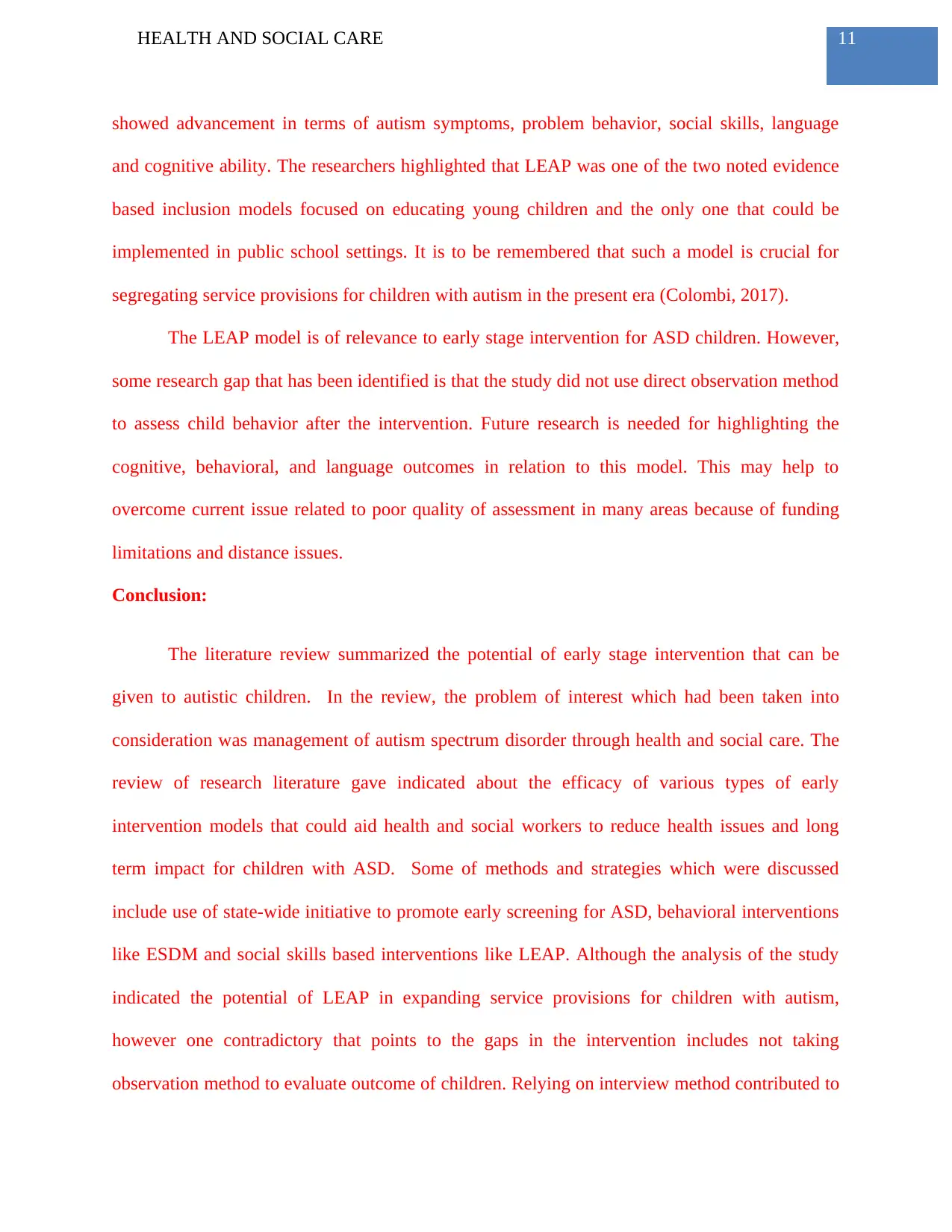
11HEALTH AND SOCIAL CARE
showed advancement in terms of autism symptoms, problem behavior, social skills, language
and cognitive ability. The researchers highlighted that LEAP was one of the two noted evidence
based inclusion models focused on educating young children and the only one that could be
implemented in public school settings. It is to be remembered that such a model is crucial for
segregating service provisions for children with autism in the present era (Colombi, 2017).
The LEAP model is of relevance to early stage intervention for ASD children. However,
some research gap that has been identified is that the study did not use direct observation method
to assess child behavior after the intervention. Future research is needed for highlighting the
cognitive, behavioral, and language outcomes in relation to this model. This may help to
overcome current issue related to poor quality of assessment in many areas because of funding
limitations and distance issues.
Conclusion:
The literature review summarized the potential of early stage intervention that can be
given to autistic children. In the review, the problem of interest which had been taken into
consideration was management of autism spectrum disorder through health and social care. The
review of research literature gave indicated about the efficacy of various types of early
intervention models that could aid health and social workers to reduce health issues and long
term impact for children with ASD. Some of methods and strategies which were discussed
include use of state-wide initiative to promote early screening for ASD, behavioral interventions
like ESDM and social skills based interventions like LEAP. Although the analysis of the study
indicated the potential of LEAP in expanding service provisions for children with autism,
however one contradictory that points to the gaps in the intervention includes not taking
observation method to evaluate outcome of children. Relying on interview method contributed to
showed advancement in terms of autism symptoms, problem behavior, social skills, language
and cognitive ability. The researchers highlighted that LEAP was one of the two noted evidence
based inclusion models focused on educating young children and the only one that could be
implemented in public school settings. It is to be remembered that such a model is crucial for
segregating service provisions for children with autism in the present era (Colombi, 2017).
The LEAP model is of relevance to early stage intervention for ASD children. However,
some research gap that has been identified is that the study did not use direct observation method
to assess child behavior after the intervention. Future research is needed for highlighting the
cognitive, behavioral, and language outcomes in relation to this model. This may help to
overcome current issue related to poor quality of assessment in many areas because of funding
limitations and distance issues.
Conclusion:
The literature review summarized the potential of early stage intervention that can be
given to autistic children. In the review, the problem of interest which had been taken into
consideration was management of autism spectrum disorder through health and social care. The
review of research literature gave indicated about the efficacy of various types of early
intervention models that could aid health and social workers to reduce health issues and long
term impact for children with ASD. Some of methods and strategies which were discussed
include use of state-wide initiative to promote early screening for ASD, behavioral interventions
like ESDM and social skills based interventions like LEAP. Although the analysis of the study
indicated the potential of LEAP in expanding service provisions for children with autism,
however one contradictory that points to the gaps in the intervention includes not taking
observation method to evaluate outcome of children. Relying on interview method contributed to
⊘ This is a preview!⊘
Do you want full access?
Subscribe today to unlock all pages.

Trusted by 1+ million students worldwide
1 out of 18
Related Documents
Your All-in-One AI-Powered Toolkit for Academic Success.
+13062052269
info@desklib.com
Available 24*7 on WhatsApp / Email
![[object Object]](/_next/static/media/star-bottom.7253800d.svg)
Unlock your academic potential
Copyright © 2020–2025 A2Z Services. All Rights Reserved. Developed and managed by ZUCOL.




